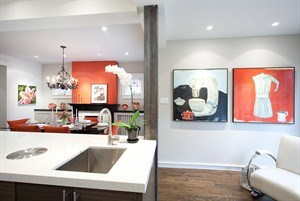
The height and proportion of art and pictures are important to consider when hanging art in a home. Shelley Kirsch recommends centring at eye level and creating borders around the pieces. THE CANADIAN PRESS/HO-Shelley Kirsch Design
March 07, 2014 - 9:48 AM
VICTORIA - How art and pictures are hung can change the way a space looks, but placing and hanging pieces properly requires a bit of skill.
Interior designer Shelley Kirsch says the most important step in putting up art in a home is to make sure it is at the right height.
"It's a good idea if you are hanging a piece to get it so the centre of the picture is at eye level," she says.
If a piece is hung too high, Kirsch says, it can be disorienting to the viewer.
"You aren't seeing it as a straight-on image," says the Toronto-based designer. "You are having to crane your neck. It takes away from what the image is when you're looking at it from underneath."
Putting a photo or painting above a couch requires considering the height of people sitting below it.
According to Kirsch, a homeowner should get a person of average height to sit on the couch and then measure 23 centimetres above and make a mark, which is where the base of the frame should be.
"If people are trying to hang something over a sofa they have to make sure when someone is sitting on the sofa their head won't be hitting the picture," says Kirsch.
Before a homeowner puts the art on the wall, Kirsch recommends looking at how the surrounding lighting will shine on the piece.
"Make sure when you are hanging your art the lighting that is shining on the piece isn't bisecting or trisecting it," she says. "You have to be conscious about how light is reflecting in the area where the piece is being hung. What you want to do is try and get an even arch. If you are dealing with pot lights like most people are, you want to make sure the whole image is being washed, not just a portion of it."
When it comes to making sure your painting is straight, Jenny Martin recommends using two hooks to make sure the piece doesn't slump.
"You can use a level to help make sure the piece is straight, and there are specific tools on the market to help hang art, but I don't know if they are that great," says the Victoria interior designer. "If you are using a wire on the back of a piece of art, that leaves more room for it to swing and move around which isn't going to keep it as straight, which is why I recommend using two fixed hooks."
Instead of the traditional look of photos centred in a linear line on the wall, many homeowners are choosing to group multiple pieces together to create a collage-type feature.
Martin says homeowners should take time to map out the grouping they are going for before they start putting nails in the wall, and to pick a common theme among the pieces.
"If you keep one element constant throughout the grouping it creates a great effect," she says. "You could have a whole bunch of coloured frames, but all the prints are black and white, or you could have frames that are the same colour but are different profiles, sizes and mouldings."
While the most common way to put a piece up on a wall is with a hammer and hook, Martin says there are many other products such as gallery-style tracks, which allow homeowners more flexibility with changing pieces.
"There are other hanging systems that don't make marks on the wall that are adjustable," says Martin. "Easels can be fun as well, making larger pieces a sculptural element.
"Picture rails are also fun. You use pieces of trim and make a ledge that you can set pieces on and lean them against the wall."
News from © The Canadian Press, 2014